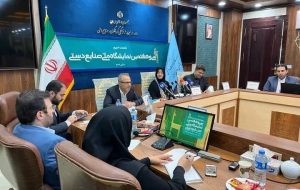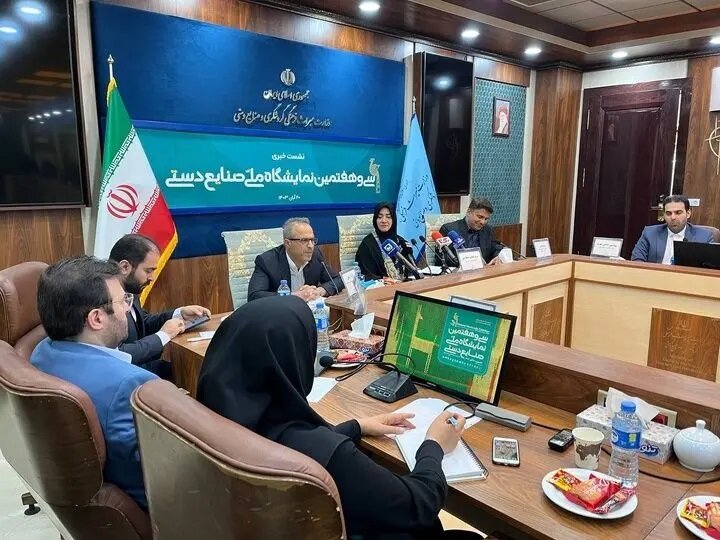Deputy minister highlights growing public role in Iran’s handicrafts sector
TEHRAN – On Sunday, Maryam Jalali-Dehkordi, Deputy Minister of Handicrafts, underlined the significant public engagement within Iran’s handicraft sector at a press conference for the 37th National Handicrafts Exhibition. Held at the Ministry of Cultural Heritage, Tourism, and Handicrafts headquarters, the event underscored evolving policies and the ministry’s emphasis on fostering collaboration across rural and


TEHRAN – On Sunday, Maryam Jalali-Dehkordi, Deputy Minister of Handicrafts, underlined the significant public engagement within Iran’s handicraft sector at a press conference for the 37th National Handicrafts Exhibition.
Held at the Ministry of Cultural Heritage, Tourism, and Handicrafts headquarters, the event underscored evolving policies and the ministry’s emphasis on fostering collaboration across rural and urban communities.
Jalali-Dehkordi explained that the ministry’s recent policies have prioritized public participation, which has led to a greater role for local organizations, knowledge-based companies, and public-private partnerships.
“Handicrafts represent one of the most inclusive sectors for public involvement in production, sales, and exports,” she said, emphasizing that the ministry has shifted its focus from individual efforts to organizational frameworks to bolster the industry.
The exhibition, taking place at the Tehran International Permanent Fairgrounds from November 13 to 16, is expected to draw artisans, craftspeople, and nomadic artists from all over Iran. For the first time, the exhibition will also offer a virtual format, allowing artisans to showcase their work online through apps like Basalam and several others.
As part of the new approach, the ministry is encouraging an integrated “ecosystem” for handicrafts to boost economic impact while preserving cultural identity.
The deputy minister noted, “In recent years, we’ve seen positive developments in the handicrafts sector…. This has strengthened our support for artisans and helped integrate modern technology with traditional crafts.”
This year’s exhibition will emphasize rural and urban collaboration, with special attention on involving local leaders and organizations.
Jalali-Dehkordi pointed out that the 37th edition of the exhibition marks a clear shift in strategy, building upon both past experiences and the most recent guidance from national development policies, which now include a dedicated section for handicrafts in Iran’s Seventh National Development Plan.
In his remarks, Farzad Ojani, the secretary of the National Handicrafts Exhibition, emphasized that the ministry’s new policies have focused on supporting marketing and restructuring fundamental frameworks. He highlighted the role of the private sector in advancing Iran’s handicraft industry and enhancing the quality of Iranian handicrafts in the global market.
Last week, the Iranian President Masoud Pezeshkian officially issued the National Document for the Development of Handicrafts, as a pivotal step to bolster the country’s traditional arts and crafts sector.
The document, approved during the 903rd session of the Supreme Council of the Cultural Revolution on August 27, sets a comprehensive framework for revitalizing and promoting Iranian handicrafts on national and international stages.
The directive has been communicated to a wide range of governmental bodies, including the Ministries of Cultural Heritage, Tourism, and Handicrafts; Economy; Foreign Affairs; Education; Agriculture; and Industry, among others. Key organizations like the Islamic Republic of Iran Broadcasting, the National Iranian Standards Organization, and various chambers of commerce will also play roles in the document’s execution.
The national strategy underscores the role of handicrafts as a cultural pillar, aiming to preserve and modernize traditional Iranian crafts while enhancing their contribution to the national economy. According to the document’s text, its objectives include increasing the share of handicrafts in the GDP, expanding domestic and international markets, and promoting the cultural identity embedded in these crafts.
The document also highlights the need for technological integration, urging adaptation to innovations such as artificial intelligence, blockchain, and the metaverse to ensure the sector remains competitive and relevant in a rapidly evolving global market.
Currently, a selection of 13 cities and three villages in Iran have been registered by the World Council of Handicrafts as “world cities of handicrafts”.
AM
